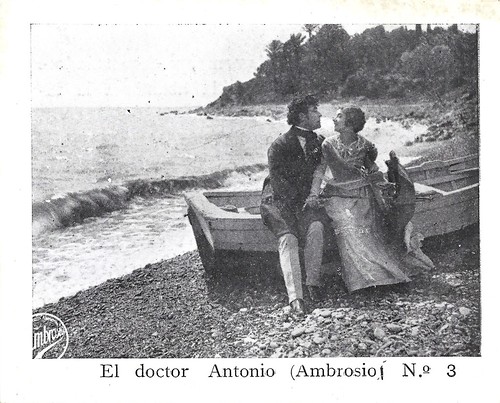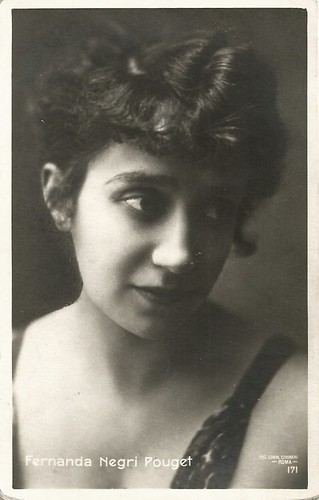
British postcard by J.F. Grimm & Co., London. Photo: Ambrosio. The elegant Glaucus is courted by women at the Via Domizia, the main street of Ancient Pompeii, in Gli ultimi giorni di Pompei (Eleuterio Rodolfi, 1913). The caption mentions Glaucus' beloved Ione, but she isn't in this scene in the film. This is from the opening scene of the film.

German postcard by Rodera-Lichtspiele, Dresden, 1913. Publicity still for Gli ultimi giorni di Pompei / The Last Days of Pompeii (Eleuterio Rodolfi, 1913). From left to right: Antonio Grisanti as Arbaces, the Egyptian High Priest of Isis; Cesare Gani Carini as Apecides; Eugenia Tettoni Fior as Jone; Ubaldo Stefani as Glaucus, Jone's lover; and Fernanda Negri Pouget as the blind slave Nidia.

British postcard by J.F. Grimm & Co., London. Photo: Ambrosio. Publicity still for Gli ultimi giorni di Pompei / The Last Days of Pompeii (Eleuterio Rodolfi, 1913). Caption: Arbaces, the priest of Isis, denounced in the temple. Left Arbaces' pupil and brother of Jone, Apecides (Cesare Gani Carini) and right Arbaces (Antonio Grisanti). Arbaces will take revenge on Apecides himself and put the blame on Glaucus, Jone's lover.

Australian poster postcard (reprint) with a Unicorn logo on the back by Ambrosio. Poster design for Gli ultimi giorni di Pompei (Eleuterio Rodolfi, 1913). 'Nydia and Ione feeding the fishes'. The actresses presented at this idyllic moment are Fernanda Negri Pouget (Nydia) and Eugenia Tettoni Fior (Ione).
A slender, frail-looking girl with sad eyes and a tip-tilted nose
Fernanda Negri Pouget was born Fernanda Negri in Rome, on 28 March 1889. She first enrolled as a pupil of the Accademia Nazionale di Santa Cecilia. In 1906, she was hired by the new Roman film company Alberini & Santoni, which would become Cines.
She debuted in the short Il romanzo di un Pierrot by Mario Caserini. Until 1909, she mostly played supporting parts, often in Film d’Art-like films by Caserini such as Romeo e Giulietta (1908) and Beatrice Cenci (1909), but as of 1909 she also had the female leads in films such as Marco Visconti (Mario Caserini 1909), La sposa del Nilo (Enrico Guazzoni 1911), San Francesco il poverello d’Assisi (Guazzoni 1911) and Santa Cecilia (Enrique Santos 1911).
Quite soon, the slender, frail-looking girl with the sad eyes and the tip-tilted nose became one of the major dramatic actresses of Italian silent cinema, challenging the dominance at Cines of ‘first actress’ Maria Gasperini Caserini, Caserini’s wife.
In 1912, she switched to the Ambrosio film company of Turin, where the year before she had already collaborated in the films L’innocente / The Innocent (Edoardo Bencivenga 1911), based on Gabriele D’Annunzio’s novel, and La madre e la morte (Arrigo Frusta 1911).
In L’innocente, she played the female lead of Giuliana Hermil, a part which sixty-five years later would be played by Laura Antonelli in Luchino Visconti’s adaptation, L’innocente / The Innocent (1976). In these years, she also married the French actor Armand Pouget, who started acting in films by Ambrosio in 1912. From then on, Fernanda was named Negri Pouget.

Italian postcard by Società Anonima Ambrosio. In the early 1910s, Maria Caserini Gasperini, Fernanda Negri Pouget and Mary Cléo Tarlarini were three major actresses of the Ambrosio film company of Turin.

Spanish collector card by Reclam Film, Mallorca, card 3 of 6. Fernanda Negri Pouget in Il dottor Antonio / Doctor Antonio (Ambrosio Film, 1914). The film, based on the novel by Giovanni Ruffini, is set in the mid-19th century and deals with an Italian revolutionary (Hamilton Revelle) who falls in love with a wealthy young Englishwoman (Fernanda Negri Pouget).

Spanish collector card by Reclam Film, Mallorca, card 6 of 6. Photo: Ambrosio Film. Fernanda Negri Pouget in Il dottor Antonio / Doctor Antonio (Eleuterio Rodolfi, 1914).

Italian postcard by Vettori, Bologna, no. 171. Photo: Civirani, Rome.
A wonderful mage of the Ambrosio studio ‘in action’
At Ambrosio, Fernanda Negri Pouget acted in many films, at first several by Mario Caserini, who had moved to Ambrosio as well, such as Nelly, la domatrice (Mario Caserini, 1912), in which Negri Pouget faced real lions when playing a female lion tamer. She also acted in films by Luigi Maggi (Satana, 1912), Febo Mari (Il critico, 1913), Eleuterio Rodolfi and others.
In 1913, Negri Pouget peaked in various Ambrosio films. She was Beatrice Portinari in Dante e Beatrice (Mario Caserini 1913), she was a grandmother who remembers her heroic deeds during the Risorgimento in La lampada della nonna (Luigi Maggi 1913), she played a newly discovered film star in Cenerentola (Eleuterio Rodolfi 1913) – the film gives a wonderful image of the Ambrosio studio ‘in action’ at the time.
Finally, she was the pitiful blind girl Nidia/Nydia in the Ambrosio version of the epic Gli ultimi giorni di Pompei / The Last Days of Pompeii (Eleuterio Rodolfi, 1913), while simultaneously, the Pasquali company of Turin made a competing version, with Suzanne De Labroy as Nidia. Later, Negri Pouget had memorable parts in Il dottor Antonio / Doctor Antonio (1914) opposite Hamilton Revelle in the title role, and in the period piece Il leone di Venezia (Luigi Maggi, 1914).
In 1917, she played three outstanding parts as poor Esther in the adventure film Il fiacre No. 13 (Alberto Capozzi, Gero Zambuto, 1917) with Elena Makowska and Alberto Capozzi, as a little vagabond turned into a painter’s model in Lucciola (Augusto Genina, 1917) with Makowska, and as a tomboy in Maschiaccio (Augusto Genina, 1917) with Vasco Creti. In the early 1920s, Negri Pouget worked for several other companies, but mainly at the Roman company Nova Film. For Nova, she e.g. played Gasperina in the Luigi Pirandello adaptation Ma non è una cosa seria (Augusto Camerini, 1921), co-starring Romano Calò, Ignazio Lupi and Carmen Boni.
Her last performance was in 1923 in the film La gola del lupo (Torello Rolli, 1923). According to critic Lucio D'Ambra, Negri Pouget was characterised by the fact that she stayed far from the languid poses of the divas, preferring the expression of a lively performance on the screen. Fernanda Negri Pouget died in Rome on 17 February 1955.

Italian postcard by Fotocelere, Turin.

Italian postcard by Fotocelere, Turin.

Italian postcard by Fotocelere.

Italian postcard by Ed. A. Traldi, Milano, no. 510.

Publicity still for Le Giornate del Cinema Muto 2025. Credit: Fototeca - Museo Nazionale del Cinema di Torino. Eugenia Tettoni Fior als Jone in Gli ultimi giorni di Pompei / The Last Days of Pompei (Eleuterio Rodolfi, 1913).
Sources: Sempre in penombra, Wikipedia (Italian) and IMDb.
No comments:
Post a Comment